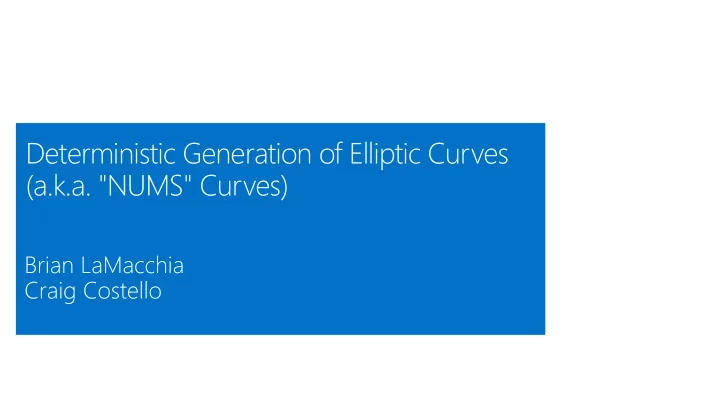

Deterministic Generation of Elliptic Curves (a.k.a. "NUMS" Curves)
Motivation • Reduced customer confidence in NIST-standardized curves (FIPS 186-3) • Industry moving to Perfect Forward Secrecy (PFS) ciphersuites (e.g. ECDHE) • We need new curves that have independently- verifiable provenance and also perform better for the standard ECC algorithms and protocols
Our Requirements (1 of 2) • New curves must support standard security levels • 128-bit and 256-bit mandatory, 192-bit desired • New curves generated deterministically from the security level • Rigid parameter generation for primes and curve constants • New curves must work with the existing ECC protocol infrastructure • Must support standard ECDHE and ECDSA algorithms • Must work with TLS 1.2, X.509v3/PKIX, CMS (both for S/MIME and code signing)
Our Requirements (2 of 2) • New curves must have good performance for both key agreement and digital signatures • New curves must support standard EC point representations • Retain existing (x,y) coordinate encoding formats • New curves must support standard group and field order bit length • Recommend alignment at CPU register boundary: 64-bit length alignment
Our EC Research • Comprehensive analysis • Curve forms and their arithmetic • Prime forms • Performance in protocols • Constant-time and exception-free implementation • Full paper at http://eprint.iacr.org/2014/130 • Open source implementation • http://research.microsoft.com/en-us/projects/nums/default.aspx
Findings -- Curve Form Pros & Cons Curve Family Pros Cons Prime order Slower than T-Edwards • • Weierstrass Widely deployed in existing Harder constant-time • • infrastructure implementation Easier constant-time Slower ECDHE than T-Edwards • • Montgomery implementation Can’t be used with ECDSA • x-coordinate only Not prime order • • Fastest overall performance Twisted • Not prime order • Easier constant-time • Edwards implementation Twisted Edwards represents the best overall option
NUMS Curves -- "Nothing Up My Sleeves" • NUMS parameter generation algorithm: Start with security level s (e.g. s = 128) 1. Find smallest c>0 such that p = 2 2s - c is prime and p 3 mod 4 2. Given this p 3. • For Weierstrass, find smallest |b| such that #E(GF(p)) and #E'(GF(p)) are prime, choose b based on smaller group order • For T-Edwards, find smallest d>0 such that #E(GF(p))=4q and #E'(GF(p))= 4q' where q, q' prime, q < q' • For standard security levels, resulting primes and curves are: Weierstrass (b) T-Edwards (d) Security Level Prime (p) E: y 2 =x 3 -3x+b E: -x 2 +y 2 =1+dx 2 y 2 128 2 256 -189 152961 15342 192 2 384 -317 -34568 333194 256 2 512 -569 121243 637608
NUMS Benchmarks: Scalar Multiplication Scalar Multiplication (in 10 3 cycles) Security Level Prime (p) Weierstrass T-Edwards Fixed base Variable base Fixed base Variable base 128 2 256 -189 107 270 82 216 192 2 384 -317 252 714 201 588 256 2 512 -569 488 1504 391 1242 Results for scalar multiplication on an Intel Core i7-2600K (Sandy Bridge) processor running Linux (Ubuntu). Compilation tool: GNU GCC.
NUMS Benchmarks: ECDHE ECDHE Cost (in 10 3 cycles) Security Level Prime (p) Weierstrass T-Edwards 128 2 256 -189 379 300 192 2 384 -317 968 791 256 2 512 -569 1993 1638 Results for ECDHE on an Intel Core i7-2600K (Sandy Bridge) processor running Linux (Ubuntu). Compilation tool: GNU GCC. • Gueron-Krasnov (2013): an implementation of the NIST curve P-256, computes ECDHE in 490,000 cycles • ECDHE cost: 1 fixed base cost + 1 variable base cost + overhead
Recommendations to CFRG • The requirements on Slides 3 & 4 should form the basis for defining new ECC curves for the IETF. • While TLS is the first group to ask for new curves, the CFRG's process and recommendations here will establish precedent for future requests from other WGs. • Our Weierstrass-form curves are suitable "drop-in" replacements for the NIST curves that provide significantly improved performance. • Our twisted Edwards curves provide even greater performance and are compatible with ECDHE, ECDSA, TLS 1.2, PKIX, CMS, ...
Questions? {bal,craigco}@microsoft.com
Recommend
More recommend